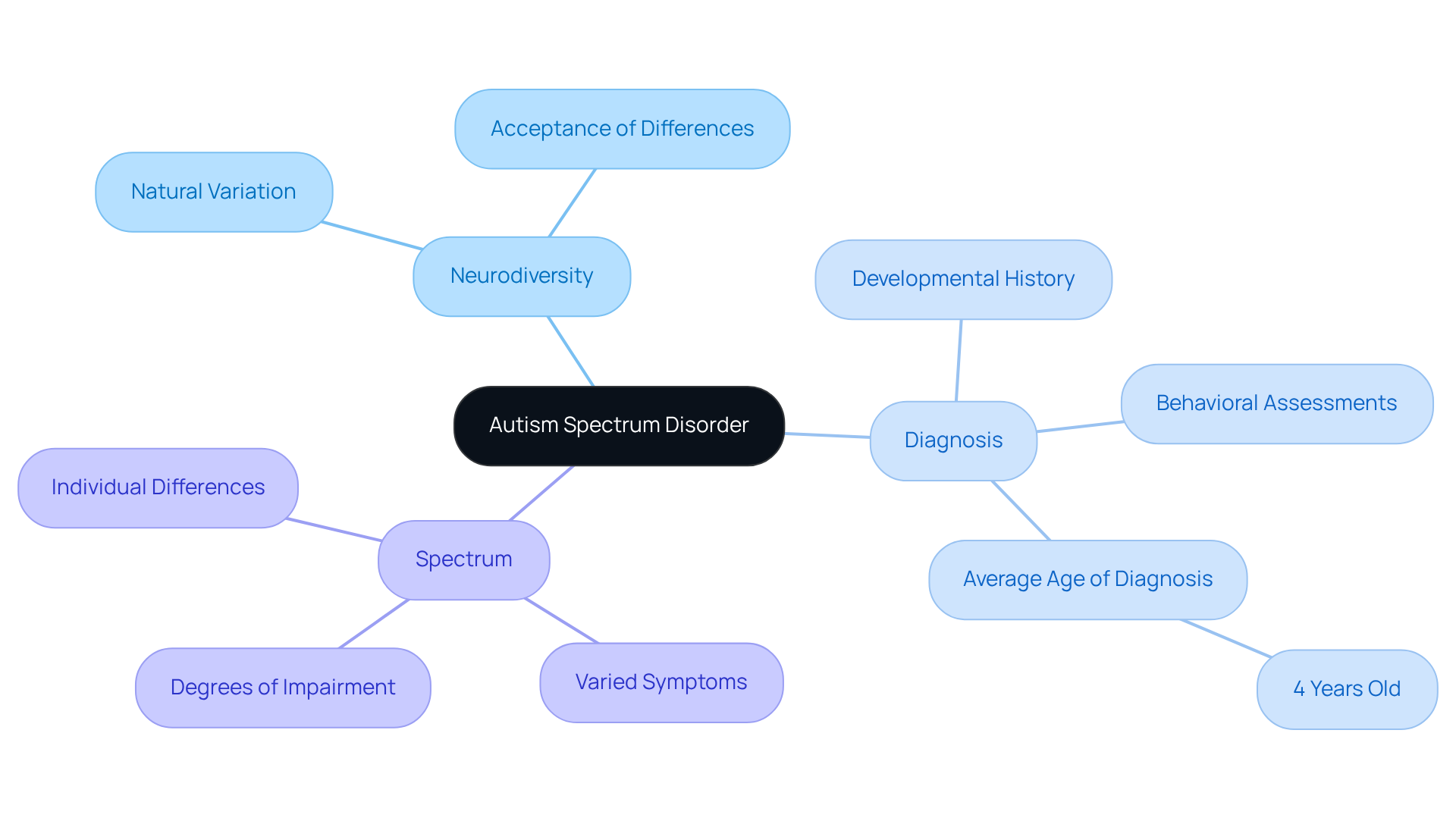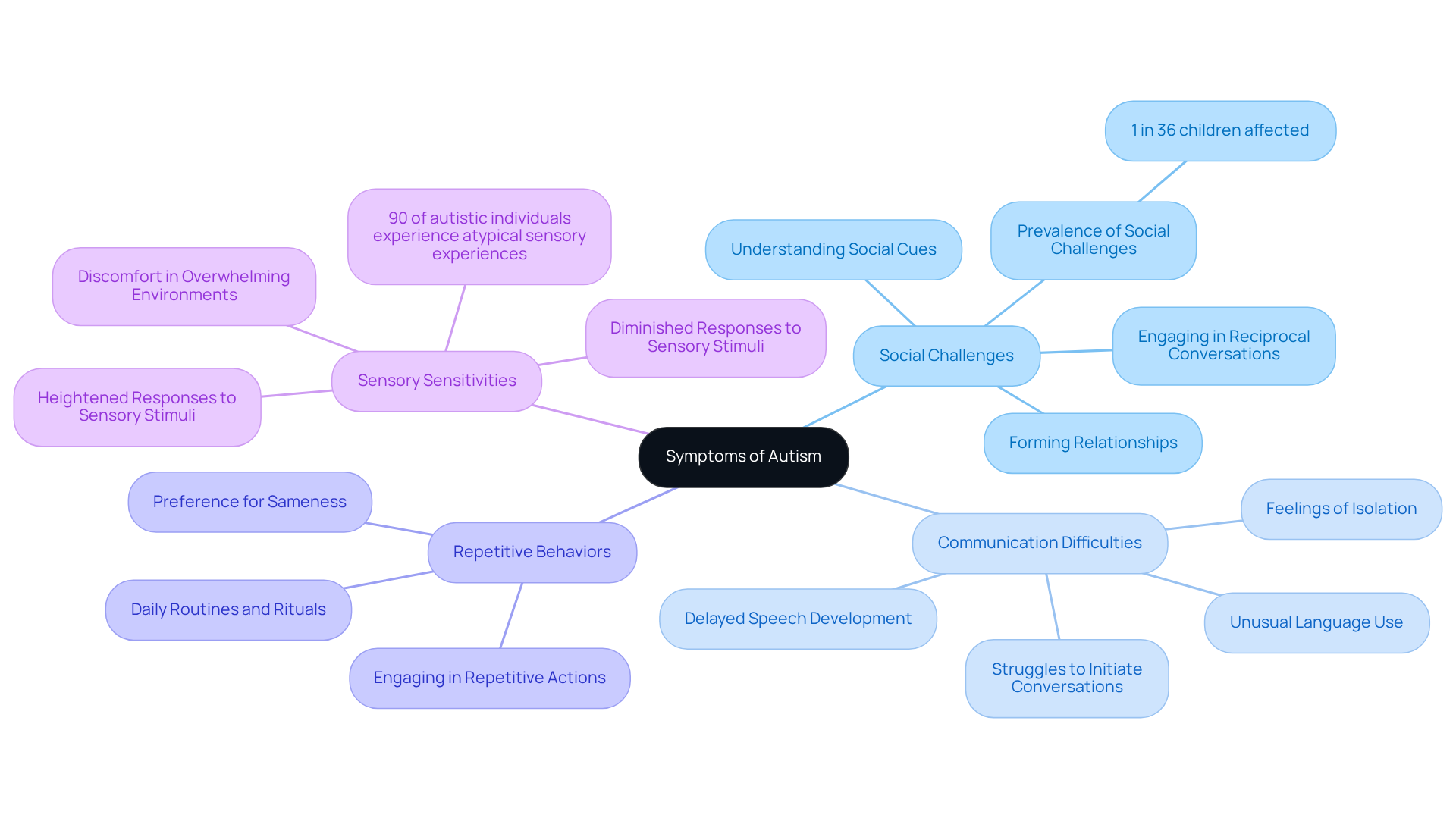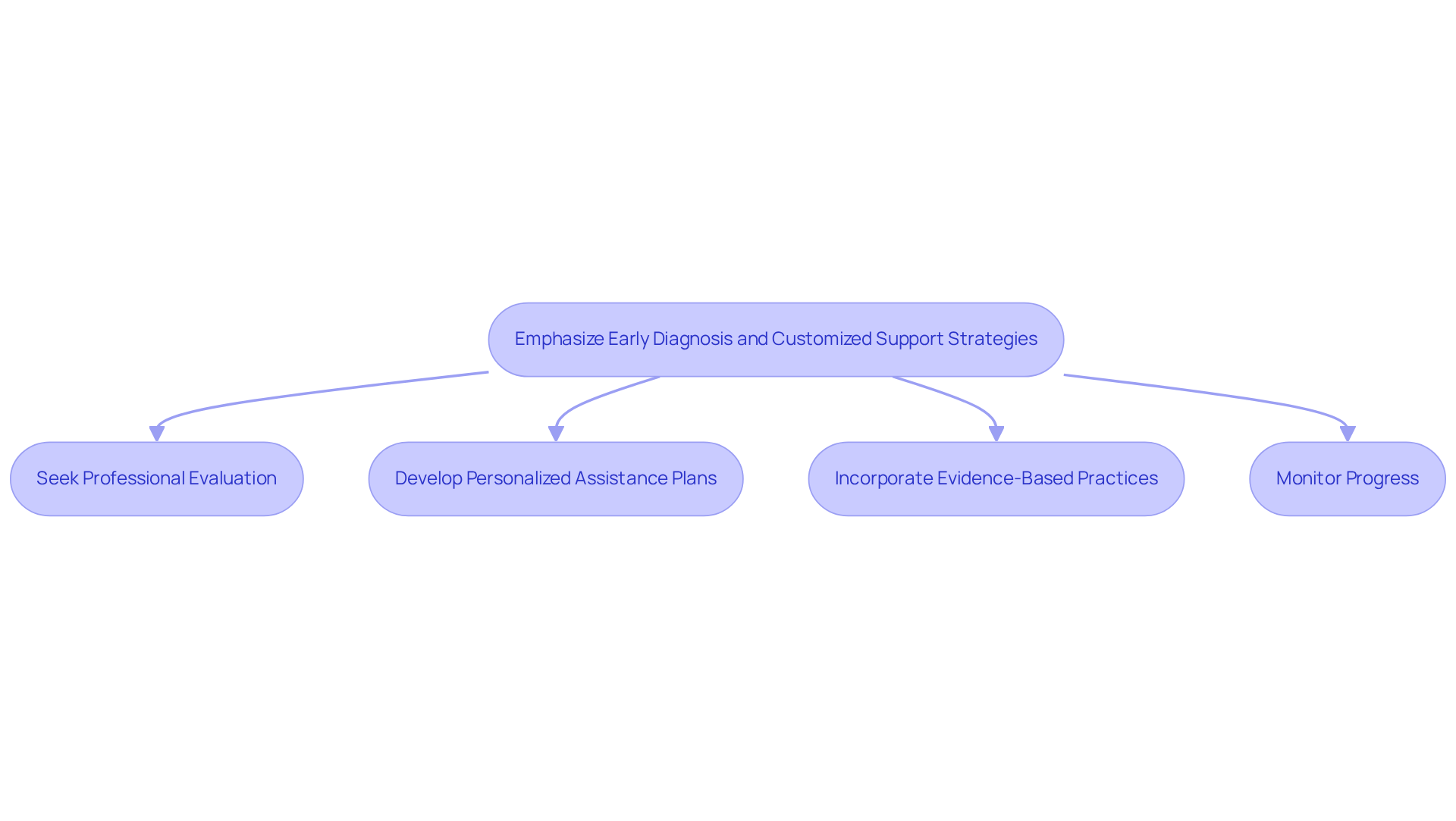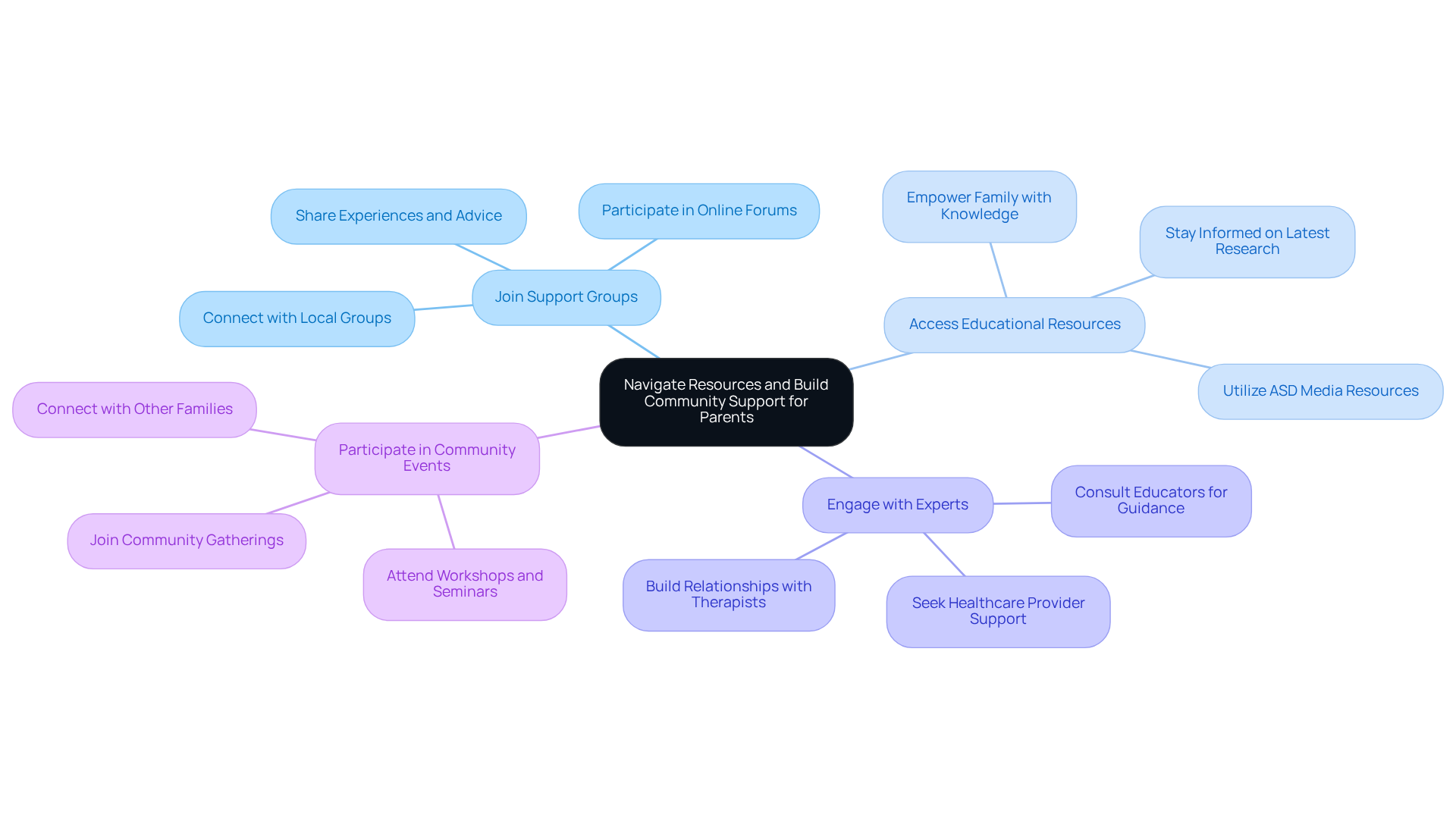Overview
Autism Spectrum Disorder (ASD) is a complex condition that presents a variety of symptoms, such as:
- Social challenges
- Communication difficulties
- Repetitive behaviors
- Sensory sensitivities
These symptoms can differ significantly from one individual to another, making each experience unique. Understanding these nuances is essential for parents and caregivers, as it allows them to provide effective interventions tailored to their child's needs.
The importance of early diagnosis cannot be overstated. Identifying ASD at a young age opens the door to personalized support strategies that can greatly enhance outcomes for children. By recognizing these symptoms early, parents can take proactive steps to ensure their child receives the help they need. This journey can be daunting, but remember, you are not alone.
As you navigate this path, consider reaching out for support and resources that can guide you. Sharing experiences with other families who face similar challenges can provide comfort and insight. Together, we can foster an environment of understanding and compassion, paving the way for brighter futures for our children with ASD.
Introduction
Understanding Autism Spectrum Disorder (ASD) is more crucial than ever, especially as awareness around this complex neurodevelopmental condition continues to grow. With autism now affecting 1 in 36 children, recognizing its key concepts and symptoms, along with the importance of early diagnosis, can truly empower families and caregivers to provide effective support.
However, many individuals still grapple with how to navigate the vast array of challenges and resources associated with the spectrum. What essential strategies can help bridge the gap between understanding and action? It’s vital that every child receives the support they need to thrive, and together, we can make a difference.
Clarify Autism Spectrum Disorder: Key Concepts and Definitions
Autism Spectrum Disorder (ASD) is a complex neurodevelopmental condition that presents a variety of challenges in social interaction, communication, and behavior. It is known as a 'spectrum' because it encompasses a wide range of signs and degrees of impairment that can vary significantly from one individual to another.
Understanding a few key concepts can be incredibly helpful for parents and professionals alike. First, there’s Neurodiversity: this idea recognizes that neurological differences, including autism, are a natural part of human diversity. Then, we have Diagnosis: ASD is diagnosed through behavioral assessments and a developmental history, typically conducted by a qualified professional. Finally, the term Spectrum highlights that individuals with ASD may exhibit varying degrees of characteristics, ranging from mild to severe, which can affect their daily functioning in unique ways.
Grasping these concepts is essential for creating an inclusive environment. By fostering understanding and compassion, we can tailor support strategies that truly meet the needs of individuals with ASD. Together, let’s work towards building a community that embraces neurodiversity and supports every individual on their journey.

Identify Symptoms and Behavioral Patterns of Autism
Identifying the signs and behavioral trends linked to developmental disorders is crucial for caregivers and specialists. Understanding these signs can be the first step toward providing the necessary support for children and their families. Common symptoms include:
- Social Challenges: Children with autism often face difficulties in understanding social cues, forming relationships, and engaging in reciprocal conversations. Recent studies reveal that these social challenges are prevalent, affecting a significant number of youth on the spectrum. For instance, el autismo spectrum condition impacts 1 in 36 youngsters, underscoring the importance of early identification of these signs.
- Communication Difficulties: Many children experience delayed speech development and struggle to initiate or maintain conversations. Some may exhibit unusual language use, complicating their interactions with peers and leading to feelings of isolation.
- Repetitive Behaviors: Engaging in repetitive actions, routines, or rituals is a hallmark of the condition. Children may display a strong preference for sameness, which can manifest in various daily activities, providing them with a sense of security.
- Sensory Sensitivities: Numerous youngsters on the spectrum experience heightened or diminished responses to sensory stimuli, such as sounds, lights, or textures. This can create discomfort in environments that are either overwhelming or under-stimulating. In fact, 90% of autistic individuals may encounter atypical sensory experiences.
By recognizing these signs, parents can take proactive steps to seek suitable assessments and interventions for el autismo, significantly enhancing outcomes for their children. Understanding these behavioral patterns is essential for creating supportive environments that cater to the unique needs of young individuals with el autismo and other developmental disorders. It’s also important to acknowledge that symptoms may differ between males and females, which can lead to later diagnoses for females. Incorporating insights from youth psychologists regarding these social challenges can further enhance understanding and support for families. We encourage you to share your experiences and thoughts in the comments or through our newsletter, as your voice matters in this journey.

Emphasize Early Diagnosis and Customized Support Strategies
Recognizing the signs of el autismo early can significantly enhance the effectiveness of interventions. As a parent, you may feel overwhelmed, but there are strategies that can empower you to support your child effectively:
- Seek Professional Evaluation: If you have concerns about your child's development, it's important to consult a healthcare professional for a thorough evaluation. This step can provide clarity and direction.
- Develop Personalized Assistance Plans: Collaborate with therapists to create tailored strategies that cater to your child's unique strengths and challenges. This personalized approach can make a world of difference.
- Incorporate Evidence-Based Practices: Embrace interventions that are grounded in research, such as Applied Behavior Analysis (ABA). These practices can foster skill development and help mitigate challenging behaviors.
- Monitor Progress: Regularly assess your child's progress and adjust assistance strategies as needed. This ensures that they are on track to achieve their developmental milestones.
By prioritizing early diagnosis and personalized support, you can play a crucial role in helping your child thrive with el autismo. Remember, you are not alone in this journey; there are resources and communities ready to support you.

Navigate Resources and Build Community Support for Parents
Establishing a nurturing network is vital for parents of children with developmental disorders. It can feel overwhelming at times, but know that you are not alone in this journey. Here are some compassionate strategies to help you navigate resources and foster community support:
- Join Support Groups: Connect with local or online support groups where you can share experiences, advice, and emotional support with others who understand your journey.
- Access Educational Resources: Take advantage of resources from organizations specializing in developmental disorders, such as ASD Media. Staying informed about the latest research and strategies can empower you and your family.
- Engage with Experts: Build relationships with therapists, educators, and healthcare providers who can offer guidance tailored to your child's unique needs. Their expertise can be invaluable in your support system.
- Participate in Community Events: Attend workshops, seminars, and community events focused on el autismo. These gatherings not only expand your knowledge but also provide opportunities to connect with other families facing similar challenges.
By actively seeking resources and building a community, you can enhance your support system and improve your child's outcomes. Remember, every step you take in fostering connections is a step towards a brighter future for your child.

Conclusion
Understanding Autism Spectrum Disorder (ASD) involves recognizing its complexity and the diverse ways it can manifest in individuals. This article has explored essential concepts such as neurodiversity, the spectrum nature of ASD, and the importance of early diagnosis. By grasping these ideas, parents and professionals can foster a more inclusive environment that supports individuals with autism in their unique journeys.
Key insights include the identification of symptoms like:
- Social challenges
- Communication difficulties
- Repetitive behaviors
- Sensory sensitivities
These elements are crucial for caregivers to understand, as they can significantly impact a child's development and quality of life. Furthermore, the necessity of early diagnosis and tailored support strategies, including professional evaluations and evidence-based practices, is emphasized to enhance outcomes for children with autism.
Ultimately, building a supportive community and accessing available resources can empower parents and caregivers. Engaging with support groups, educational resources, and expert guidance allows families to navigate the challenges of autism together. Embracing the principles of neurodiversity and fostering understanding not only benefits individuals with ASD but also enriches society as a whole. By taking these steps, we can lead to a brighter future for children on the spectrum and their families.
Frequently Asked Questions
What is Autism Spectrum Disorder (ASD)?
Autism Spectrum Disorder (ASD) is a complex neurodevelopmental condition characterized by challenges in social interaction, communication, and behavior. It is referred to as a 'spectrum' due to the wide range of signs and degrees of impairment that can vary significantly among individuals.
What does the term "Neurodiversity" mean in relation to autism?
Neurodiversity is the concept that recognizes neurological differences, including autism, as a natural part of human diversity. It emphasizes the value of varied neurological conditions and perspectives.
How is Autism Spectrum Disorder diagnosed?
ASD is diagnosed through behavioral assessments and a developmental history, which are typically conducted by qualified professionals.
What does the term "Spectrum" signify in Autism Spectrum Disorder?
The term "Spectrum" highlights that individuals with ASD can exhibit varying degrees of characteristics, ranging from mild to severe, which can uniquely affect their daily functioning.
Why is understanding these key concepts important?
Understanding key concepts related to ASD is essential for creating an inclusive environment. It fosters understanding and compassion, enabling tailored support strategies that meet the needs of individuals with ASD.




